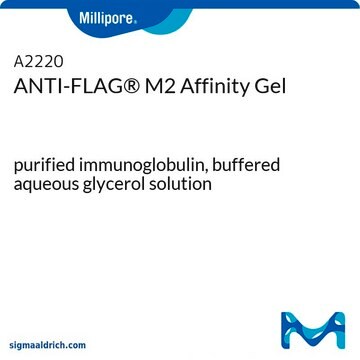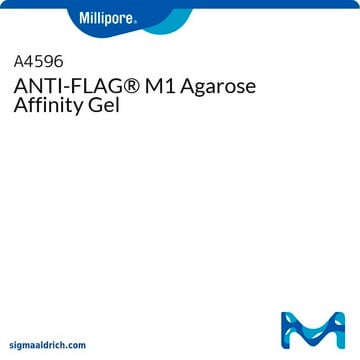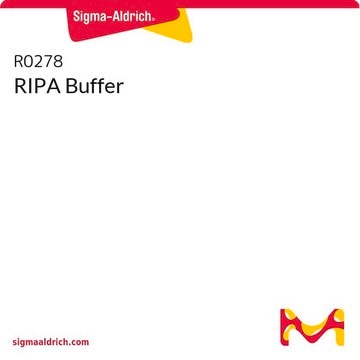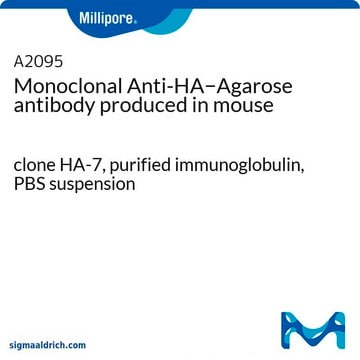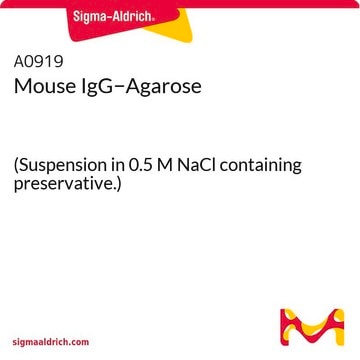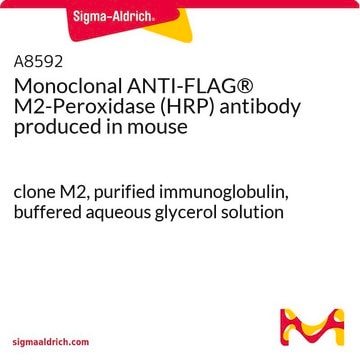As a result of the conjugation, there may be some M2 antibody that is not conjugated to the resin, but is associated with the resin and may appear in acid elutions as heavy and light chain when using the anti-mouse IgG conjugated secondary antibody. We recommend a acid wash (0.1 M glycine-HCL pH 3.5) and neutralization of the resin (do not allow the acid wash to sit on the resin longer than 20 minutes) prior to applying the lysate. Another way to avoid this is to use a directly conjugated FLAG antibody for detection such as product A8592 ant-FLAG M2 HRP, or the rabbit anti-FLAG polyclonal antibody, F7425.
F2426
Gel de afinidade M2 EZview™ Vermelho ANTI-FLAG®
clone M2
Sinônimo(s):
ANTI-FLAG® M2 monoclonal, Anti-ddddk, Anti-dykddddk
Selecione um tamanho
Selecione um tamanho
About This Item
Produtos recomendados
clone
M2, monoclonal
Nível de qualidade
classe(s) química(is) do analito
proteins
técnica(s)
affinity chromatography: suitable
immunoprecipitation (IP): suitable
Matriz
4% agarose bead; 45-165μm bead size
Isotipo
IgG1
capacidade
≥0.6 mg/mL, gel binding capacity
Condições de expedição
wet ice
temperatura de armazenamento
−20°C
Procurando produtos similares? Visita Guia de comparação de produtos
Descrição geral
Especificidade
Aplicação
Eluição - peptídeo FLAG, glicina, pH 3,5, 3x peptídeo FLAG
Saiba mais detalhes do produto em nosso portal de aplicações FLAG®.
forma física
Informações legais
Exoneração de responsabilidade
produto relacionado
Código de classe de armazenamento
10 - Combustible liquids
Classe de risco de água (WGK)
WGK 3
Ponto de fulgor (°F)
Not applicable
Ponto de fulgor (°C)
Not applicable
Escolha uma das versões mais recentes:
Certificados de análise (COA)
Não está vendo a versão correta?
Se precisar de uma versão específica, você pode procurar um certificado específico pelo número do lote ou da remessa.
Já possui este produto?
Encontre a documentação dos produtos que você adquiriu recentemente na biblioteca de documentos.
Os clientes também visualizaram
Protocolos
Protocol for immunoprecipitation (IP) of FLAG fusion proteins using M2 monoclonal antibody 4% agarose affinity gels
Conteúdo relacionado
Protein purification techniques, reagents, and protocols for purifying recombinant proteins using methods including, ion-exchange, size-exclusion, and protein affinity chromatography.
Técnicas de purificação de proteínas, reagentes e protocolos para purificar proteínas recombinantes usando métodos que incluem cromatografia de troca iônica, cromatografia de exclusão por tamanho e cromatografia por afinidade a proteínas.
Protein expression technologies for various expression systems supporting research, therapeutics, and vaccine production.
Tecnologias de expressão de proteínas de diversos sistemas de expressão usados na produção de pesquisas, tratamentos e vacinas.
-
When using Product F2426, EZview™ Red ANTI-FLAG® M2 Affinity Gel clone M2, I see bands at 20-25 kDa and 50-60 kDa appearing in my Westerns that are not my FLAG-tagged protein. How can I prevent this?
1 answer-
Helpful?
-
-
What is the binding capacity of the Product F2426, EZview™ Red ANTI-FLAG® M2 Affinity Gel clone M2, resin?
1 answer-
The binding capacity of the resin must be ? 0.6 mg/mL to meet specifications. This capacity will vary from lot to lot.
Helpful?
-
-
When using Product F2426, EZview™ Red ANTI-FLAG® M2 Affinity Gel clone M2, I have a lot of non-specific proteins that are eluting with my FLAG-tagged protein. How can I get rid of these?
1 answer-
One way to remove non-specific proteins is to pre-bind the protein lysate with unconjugated resin. We recommend product 4B200 for this purpose. Other methods would be to increase the stringency of the washes by increasing salt concentration (the resin can tolerate up to 1M NaCl) or including detergents that are compatible with the resin.
Helpful?
-
-
What is the Department of Transportation shipping information for this product?
1 answer-
Transportation information can be found in Section 14 of the product's (M)SDS.To access the shipping information for this material, use the link on the product detail page for the product.
Helpful?
-
-
When using Product F2426, EZview™ Red ANTI-FLAG® M2 Affinity Gel clone M2, how can I elute my protein?
1 answer-
Elution with the peptide is the most gentle method. Acid elution (0.1 M glycine-HCL pH 3.5) is a more stringent method of elution, and should be evaluated for its effect on your protein if it is to be used in downstream applications. Boiling the resin in sample buffer is the most denaturing condition. If this condition is used, the resin cannot be re-used, due to the presence of SDS and/or reducing agents.
Helpful?
-
-
When using Product F2426, EZview™ Red ANTI-FLAG® M2 Affinity Gel clone M2, should I use a 3X FLAG peptide or a 1X FLAG peptide to elute my protein?
1 answer-
If you have a 3X FLAG-tagged protein, then you will need to use the 3X FLAG peptide. If you have a 1X FLAG-tagged protein, you can use the 1X FLAG peptide or the 3X FLAG peptide. We have not noticed a significant difference in elution efficiency by using a 3X FLAG peptide on a 1X FLAG-tagged protein.
Helpful?
-
Active Filters
Nossa equipe de cientistas tem experiência em todas as áreas de pesquisa, incluindo Life Sciences, ciência de materiais, síntese química, cromatografia, química analítica e muitas outras.
Entre em contato com a assistência técnica